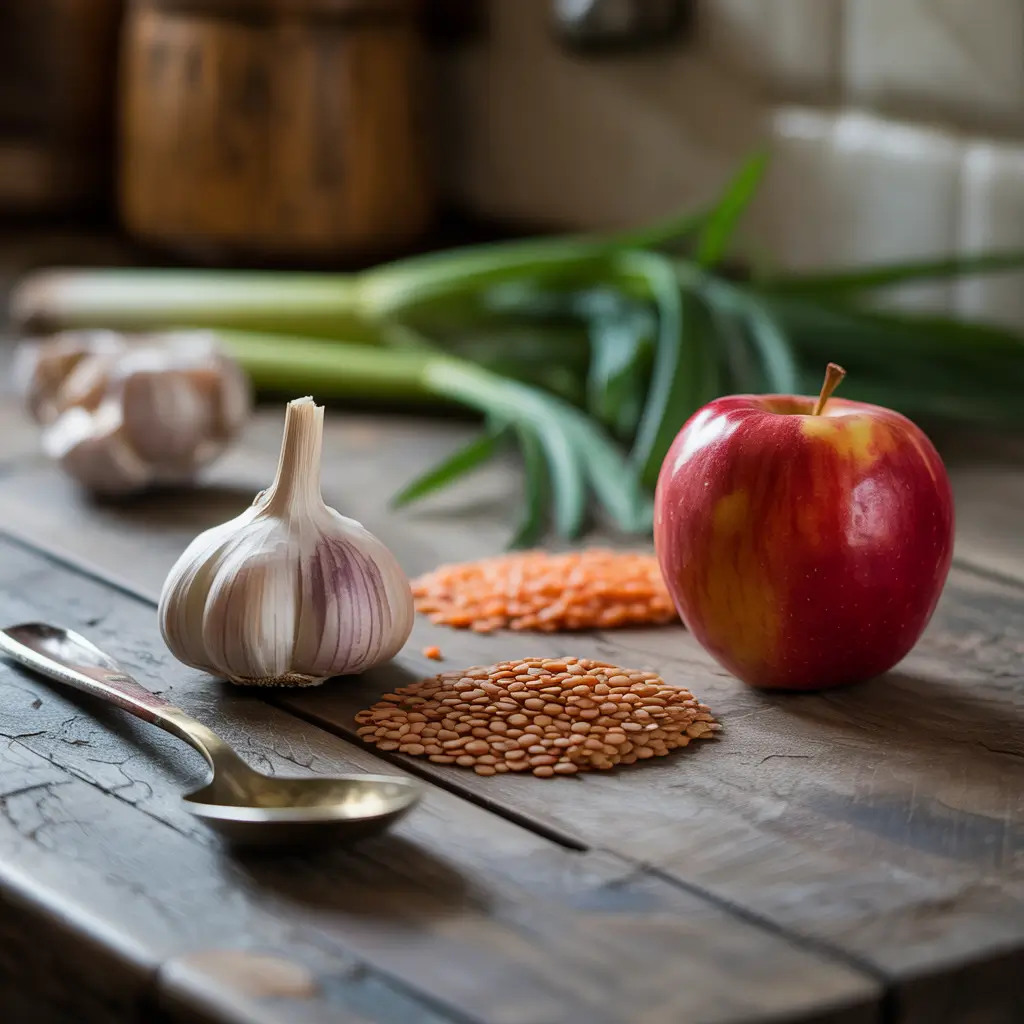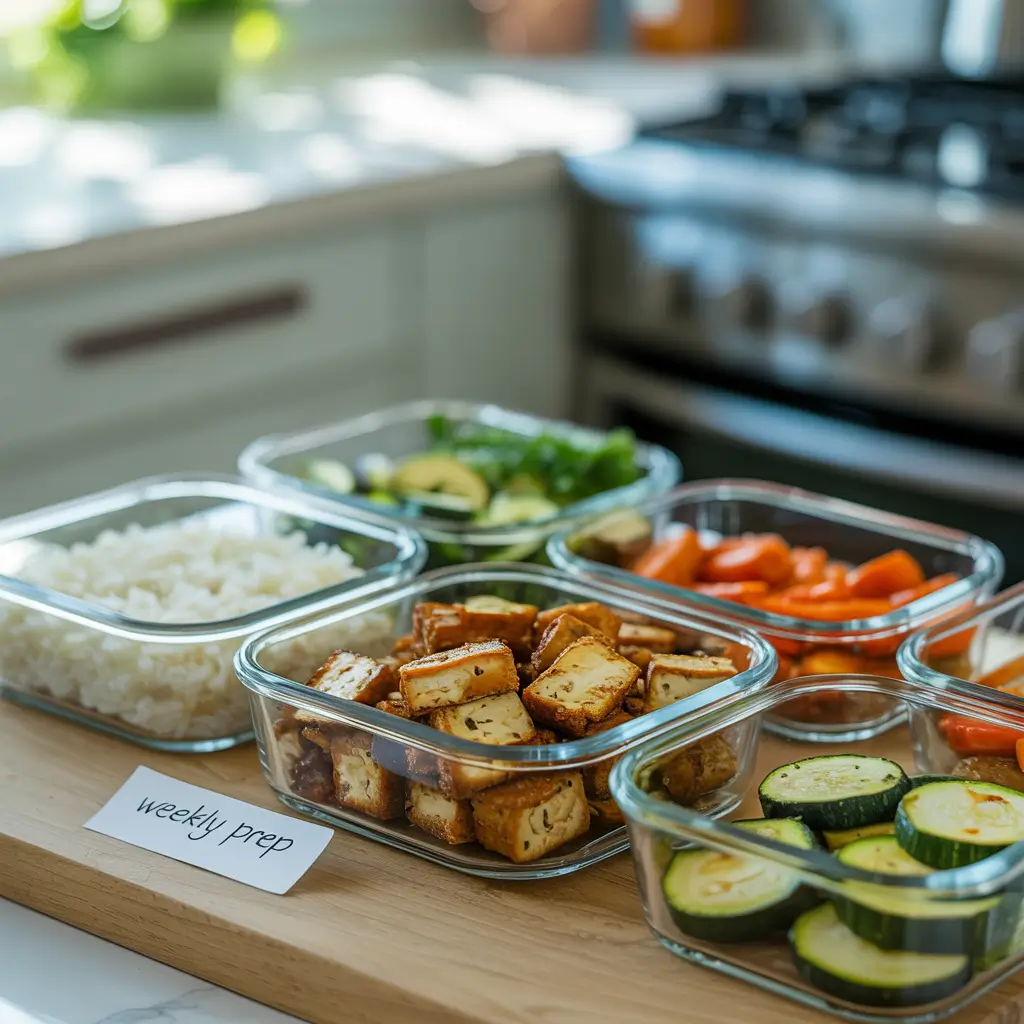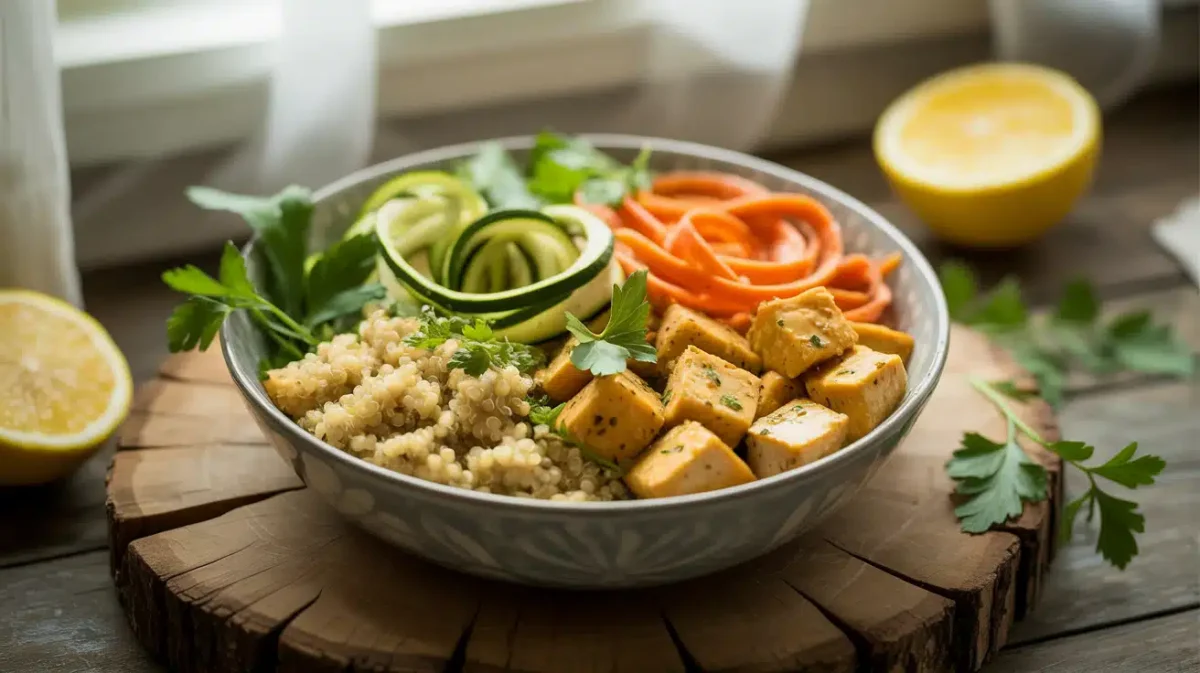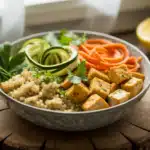Introduction
A vegan low FODMAP diet is ideal for those wanting the benefits of plant-based eating while easing digestive issues like IBS. It combines vegan principles—avoiding animal products—with the low FODMAP approach, which helps reduce bloating, gas, and gut discomfort. In this guide, you’ll discover how the diet works, foods to avoid, practical meal planning tips, and answers to common FAQs. It’s a complete roadmap to staying vegan without sacrificing digestive comfort.. Discover great ideas like gut-friendly vegan recipes in our healthy eating section at HighTasty. for more inspiration look at our pinterest
Vegan Low FODMAP Diet: The Complete Guide for Gut-Friendly Plant-Based Eating
A complete guide to the Vegan Low FODMAP Diet—perfect for easing digestive issues like IBS while staying true to a plant-based lifestyle. Learn which foods to avoid, safe staples, meal planning tips, and how to balance nutrition without gut discomfort.
- Prep Time: 10 minutes
- Cook Time: 20 minutes
- Total Time: 30 minutes
- Yield: 2 servings
- Category: Diet Guide
- Method: Meal Prep
- Cuisine: Vegan
- Diet: Vegan
Ingredients
- Firm tofu
- Quinoa
- Rice (brown or white)
- Oats
- Tempeh (in moderation)
- Hemp seeds
- Pumpkin seeds
- Spinach
- Zucchini
- Carrots
- Cucumber
- Bell peppers
- Blueberries
- Strawberries
- Kiwi
- Oranges
- Chia seeds
- Flaxseeds
- Garlic-infused olive oil
- Herbs (parsley, basil, chives)
Instructions
- Base meals around low FODMAP grains like quinoa, rice, and oats.
- Incorporate safe proteins such as tofu, tempeh, hemp seeds, and pumpkin seeds.
- Add colorful low FODMAP vegetables like spinach, zucchini, carrots, and bell peppers.
- Choose low FODMAP fruits like kiwi, oranges, strawberries, and blueberries for snacks or desserts.
- Use garlic-infused olive oil and fresh herbs instead of onion or garlic.
- Plan meals ahead to ensure protein, carbs, and healthy fats are balanced daily.
- Track digestion and adjust food portions to avoid triggers.
Notes
Stick to Monash University’s FODMAP guidelines for portion sizes. Avoid high-FODMAP beans, lentils, garlic, and onions. Smart substitutions like garlic-infused oils, green onion tops, and safe fruits keep meals flavorful without IBS triggers.
Nutrition
- Serving Size: 1 meal
- Calories: 380
- Sugar: 6g
- Sodium: 220mg
- Fat: 12g
- Saturated Fat: 2g
- Unsaturated Fat: 9g
- Trans Fat: 0g
- Carbohydrates: 48g
- Fiber: 7g
- Protein: 18g
- Cholesterol: 0mg
Keywords: vegan low fodmap diet, gut health, IBS friendly, plant based digestion, vegan meal plan
Understanding the Vegan Low FODMAP Diet
What is a vegan low FODMAP diet?
A vegan low FODMAP diet is a fusion of two dietary approaches: veganism and the low FODMAP eating plan. Veganism eliminates all animal products, focusing on plant-based foods like fruits, vegetables, legumes, grains, nuts, and seeds. The low FODMAP diet, on the other hand, was developed by researchers at Monash University to help people with irritable bowel syndrome (IBS) reduce digestive discomfort. FODMAPs—short for fermentable oligosaccharides, disaccharides, monosaccharides, and polyols—are short-chain carbohydrates that can ferment in the gut and cause symptoms such as bloating, diarrhea, or constipation. Combining the two creates a specialized eating pattern designed for vegans with sensitive digestive systems.
How it helps with gut health and digestion
For many, IBS symptoms can make sticking to a vegan diet tricky. Beans, lentils, garlic, onions, and certain fruits are rich in FODMAPs and often trigger bloating or discomfort. A vegan low FODMAP diet works by reducing these fermentable carbs while still ensuring adequate nutrition through carefully chosen plant-based alternatives. By lowering FODMAP intake, individuals often experience fewer IBS flare-ups, better bowel regularity, and less abdominal pain. At the same time, the vegan aspect of this diet supports ethical food choices, environmental sustainability, and improved long-term health.
The Science Behind FODMAPs and IBS
What are FODMAPs?
FODMAPs are a group of short-chain carbohydrates that are poorly absorbed in the small intestine. The word FODMAP is an acronym that refers to a group of short-chain carbohydrates known as Fermentable Oligosaccharides, Disaccharides, Monosaccharides, and Polyols. When these carbs reach the large intestine, gut bacteria ferment them quickly, producing gas and drawing in water. This combination often results in bloating, abdominal pain, constipation, or diarrhea. Foods high in FODMAPs include common staples such as onions, garlic, apples, wheat, and many legumes. While healthy for most people, these foods can cause major discomfort for those with sensitive digestive systems.
Connection between FODMAPs and irritable bowel syndrome
Research, particularly from Monash University, has shown that a low FODMAP diet can significantly reduce symptoms of irritable bowel syndrome (IBS). For individuals living with IBS, limiting high-FODMAP foods helps to decrease fermentation and fluid retention in the gut, easing symptoms. The challenge, however, is maintaining proper nutrition while following such restrictions. This is where the vegan low FODMAP diet requires careful planning. Since many vegan protein sources—like beans and lentils—are naturally high in FODMAPs, vegans with IBS must rely on carefully chosen alternatives such as tofu, tempeh, quinoa, and specific nuts or seeds.
In short, FODMAPs aren’t inherently “bad,” but for those with IBS, they can act as powerful triggers. By understanding how FODMAPs work and why they affect digestion, it becomes easier to craft a diet that supports gut health without abandoning the ethical and environmental values of veganism.
Challenges of Combining Vegan and Low FODMAP Diets

Nutritional considerations for vegans
Following a vegan low FODMAP diet can feel overwhelming because it requires balancing two restrictive approaches at once. On the vegan side, the goal is to avoid all animal products while still meeting essential nutrient needs like protein, iron, calcium, omega-3s, and vitamin B12. On the low FODMAP side, the goal is to limit certain carbohydrates that trigger digestive issues. The overlap creates unique challenges. For example, many high-protein vegan staples such as chickpeas, lentils, and black beans are also high in FODMAPs, making them unsuitable during the elimination phase of the diet. Without careful planning, this combination can lead to nutritional gaps or feelings of restriction.
Common high-FODMAP vegan foods to avoid
Another challenge lies in identifying which plant-based foods are safe. While vegan diets thrive on fruits, vegetables, legumes, and whole grains, many of these fall into the high-FODMAP category. For instance, apples, pears, onions, garlic, cauliflower, cashews, and most beans are all high in fermentable carbohydrates. Removing them can make meal planning more complicated, particularly for those who rely on beans and nuts as protein sources. The key is to learn which foods are safe in moderate amounts and which should be avoided altogether. Fortunately, alternatives like firm tofu, quinoa, pumpkin seeds, and certain low-FODMAP vegetables offer safe substitutes to keep meals satisfying.
Although the vegan low FODMAP diet comes with clear challenges, understanding these obstacles is the first step toward building a well-rounded eating plan that nourishes the body while protecting gut health.
Benefits of a Vegan Low FODMAP Diet
Improved digestion and reduced bloating
One of the biggest advantages of following a vegan low FODMAP diet is improved digestive comfort. For people with IBS, high-FODMAP foods often trigger bloating, cramping, and irregular bowel movements. By lowering the intake of fermentable carbohydrates, digestion becomes smoother and less painful. Pairing this approach with plant-based eating means you’re still consuming fiber-rich, nutrient-dense foods, but without the ingredients most likely to upset your gut. Over time, many people notice less bloating, more consistent energy levels, and fewer digestive flare-ups, which can significantly improve daily quality of life.
Ethical and environmental benefits
Beyond digestive relief, a vegan low FODMAP lifestyle also supports broader ethical and environmental goals. Choosing plant-based foods reduces reliance on animal agriculture, which is linked to greenhouse gas emissions and deforestation. For individuals who are both environmentally conscious and managing digestive health, this diet offers the best of both worlds. It allows you to eat in a way that aligns with your values while protecting your body from discomfort.
Moreover, focusing on whole, minimally processed plant-based foods can also improve overall health. Research consistently shows that vegan diets are associated with lower risks of chronic diseases like heart disease and type 2 diabetes. When combined with the gut-friendly principles of a low FODMAP plan, the result is a diet that not only soothes digestion but also promotes long-term wellness.
Key Foods in a Vegan Low FODMAP Diet
Low-FODMAP plant-based staples
When following a vegan low FODMAP diet, it’s crucial to identify which plant-based foods are safe and satisfying. Fortunately, there are plenty of staples that provide essential nutrients without triggering digestive issues. Grains like rice, oats, quinoa, and corn are all low FODMAP and versatile enough to form the base of many meals. Vegetables such as zucchini, bell peppers, spinach, carrots, and cucumbers are gut-friendly and add fiber, vitamins, and color to your plate. Fruits like strawberries, blueberries, kiwi, grapes, and oranges are generally well-tolerated in moderate servings, making them perfect for snacks or desserts. For fats and healthy omegas, small portions of chia seeds, flaxseeds, and walnuts can be included.
Sample food list and grocery guide
Building a grocery list tailored for a vegan low FODMAP diet ensures you always have the right ingredients at hand. For protein, focus on firm tofu, tempeh, edamame (in small servings), hemp seeds, and pumpkin seeds. Dairy substitutes such as almond milk, oat milk (if certified low FODMAP), and coconut yogurt provide creamy alternatives without discomfort. When it comes to condiments, opt for garlic-infused oils instead of whole garlic, and use herbs like basil, parsley, and chives for flavoring. Planning ahead with these foods not only helps you avoid triggers but also keeps your meals balanced and enjoyable.
Vegan Low FODMAP Diet: A Plant-Based Approach to Digestive Wellness
The vegan low FODMAP diet offers a balanced approach for individuals managing digestive sensitivities while following a plant-based lifestyle. It emphasizes low-FODMAP plant foods such as firm tofu, zucchini, quinoa, and berries, helping reduce bloating and discomfort. This diet supports gut health, energy, and ethical eating, proving that veganism and digestive wellness can work seamlessly together.
By centering your diet on these safe staples, you can maintain digestive comfort while still embracing the variety and nutrition of a plant-based lifestyle.
Vegan Low FODMAP Meal Planning

Breakfast, lunch, dinner, and snack ideas
Meal planning on a vegan low FODMAP diet may seem restrictive at first, but with the right combinations, it becomes both enjoyable and nourishing.A nourishing breakfast idea is overnight oats prepared with almond milk, chia seeds, fresh blueberries, and a touch of maple syrup. Another great choice is a tofu scramble with zucchini, bell peppers, and spinach served alongside gluten-free toast. Lunch can feature quinoa bowls with roasted carrots, cucumbers, and a tahini-lemon dressing. Dinner might include grilled tempeh with rice and sautéed low-FODMAP veggies like bok choy or eggplant. Snacks could be as easy as a handful of pumpkin seeds, kiwi slices, or rice cakes with peanut butter.
Balancing macronutrients on a restricted diet
One of the main challenges in a vegan low FODMAP diet is ensuring meals are balanced with protein, carbs, and healthy fats. To prevent nutrient gaps, it’s important to include a protein source in every meal, such as tofu, tempeh, hemp seeds, or quinoa. Pair these with complex carbs like brown rice or oats, and add colorful vegetables for fiber and antioxidants. Healthy fats from walnuts, chia, or flaxseeds can round out your meals and support satiety. Planning meals in advance also reduces stress and makes it easier to avoid high-FODMAP triggers.
When approached thoughtfully, meal planning ensures that your diet stays diverse, nutrient-dense, and satisfying without sacrificing digestive comfort.
Protein Sources for Vegan Low FODMAP Diet
Best low FODMAP protein options
One challenge of a vegan low FODMAP diet is meeting protein needs without beans, lentils, or chickpeas, which are high in FODMAPs. Fortunately, gut-friendly alternatives exist. Firm tofu is versatile, protein-rich, and easy to use in stir-fries, scrambles, or salads. Tempeh in moderation adds probiotics, while quinoa serves as a complete protein and hearty base. Seeds like pumpkin, hemp, and chia boost protein, healthy fats, and minerals.
Tips to meet protein requirements daily
The key to thriving on a vegan low FODMAP diet is variety. Aim to include a mix of protein sources throughout the day rather than relying on a single ingredient. For example, breakfast could feature chia seed pudding, lunch a quinoa and tofu bowl, and dinner a tempeh stir-fry with vegetables. Smoothies with hemp protein powder or fortified plant-based milks can help fill any gaps. Planning portions is also important, since eating too much of certain foods—like edamame—may shift them from low to high FODMAP. By diversifying your protein intake, you can maintain digestive comfort while still hitting your daily requirements.
Practical Tips for Success

Eating out on a vegan low FODMAP diet
Following a vegan low FODMAP diet doesn’t mean giving up restaurant meals. The key is planning ahead. Check menus online and look for dishes that can be customized—like rice bowls, veggie stir-fries, or salads with safe ingredients such as zucchini, carrots, or spinach. Politely ask servers to skip garlic, onions, or high-FODMAP sauces, and don’t hesitate to bring a small low-FODMAP dressing from home. Eating a quick safe snack beforehand can also help you avoid risky choices. With time, you’ll find restaurants that reliably accommodate both vegan and low FODMAP needs, making dining out much easier.
Label reading and smart substitutions
Packaged foods often hide high-FODMAP ingredients like inulin, apple juice concentrate, or agave syrup—even in vegan staples such as yogurts, sauces, and protein bars. Reading labels carefully is essential. Stick to shorter ingredient lists with recognizable whole foods. When in doubt, apps like Monash FODMAP can confirm what’s safe. Substitutions also keep meals flavorful without the gut triggers. Garlic-infused olive oil or green onion tops replace onions; peanuts or walnuts can stand in for cashews; maple syrup or rice malt syrup work instead of honey. For creamy textures, coconut yogurt or blended tofu can replace dairy. With a few smart swaps, you can enjoy variety, flavor, and gut comfort while staying committed to vegan low FODMAP eating.
Vegan Low FODMAP Diet FAQs
Can you be low FODMAP and vegan?
Yes. With smart planning, you can enjoy a vegan low FODMAP diet. Focus on safe staples like tofu, quinoa, oats, zucchini, spinach, and low-FODMAP fruits such as berries and oranges.
What is the 80/20 rule for vegans?
The 80/20 rule means eating mostly (80%) whole, nutrient-rich plant foods and allowing flexibility (20%) for less strict options. For low FODMAP vegans, it helps balance gut comfort with variety.
Can a vegan diet trigger IBS?
It can if it relies on high-FODMAP foods like beans, lentils, apples, garlic, or onions. Swapping those for low-FODMAP choices supports digestion and reduces IBS flare-ups.
What is the best low FODMAP protein for vegans?
Top options include firm tofu, tempeh, quinoa, peanuts, chia, and hemp seeds. These provide protein without common digestive triggers.
Conclusion
Balancing gut health with a plant-based lifestyle can feel challenging, but a vegan low FODMAP diet makes it possible. By focusing on safe, nutrient-dense foods like tofu, quinoa, zucchini, spinach, and low-FODMAP fruits, you can ease IBS symptoms without giving up vegan values. Careful planning, smart substitutions, and mindful eating out allow you to enjoy variety while protecting digestion.
This approach not only reduces bloating and discomfort but also supports ethical and sustainable food choices. Whether you’re new to low FODMAP eating or refining your vegan routine, remember that flexibility and preparation are key. With the right strategies, you can enjoy meals that are gut-friendly, plant-based, and deeply satisfying.
for more inspiration visite our facebook



3 thoughts on “Vegan Low FODMAP Diet: The Complete Guide for Gut-Friendly Plant-Based Eating”
Comments are closed.